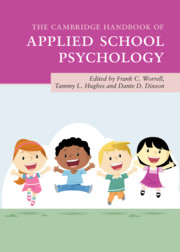Book contents
- The Cambridge Handbook of Applied School Psychology
- The Cambridge Handbook of Applied School Psychology
- Copyright page
- Contents
- Contributors
- Contributor Biographies
- Acknowledgments
- 1 Broadening the Focus of School Psychology Practice
- Part I Individual-Level Academic Interventions
- Part II Teacher- and System-Level Interventions
- Part III Interventions from Educational and Social/Personality Psychology
- Part IV Behavioral and Social-Emotional Interventions
- Part V Health and Pediatric Interventions
- 26 Impairments Related to Medical Conditions
- 27 Psychological Considerations for Asthma
- 28 Substance Use and Misuse Prevention: Guidance for Practitioners
- 29 Coordinating Services with Nonschool Providers
- Part VI Family Connections and Life Transitions
- Part VII Special Populations
- Part VIII Conclusion
- Index
- References
28 - Substance Use and Misuse Prevention: Guidance for Practitioners
from Part V - Health and Pediatric Interventions
Published online by Cambridge University Press: 18 September 2020
- The Cambridge Handbook of Applied School Psychology
- The Cambridge Handbook of Applied School Psychology
- Copyright page
- Contents
- Contributors
- Contributor Biographies
- Acknowledgments
- 1 Broadening the Focus of School Psychology Practice
- Part I Individual-Level Academic Interventions
- Part II Teacher- and System-Level Interventions
- Part III Interventions from Educational and Social/Personality Psychology
- Part IV Behavioral and Social-Emotional Interventions
- Part V Health and Pediatric Interventions
- 26 Impairments Related to Medical Conditions
- 27 Psychological Considerations for Asthma
- 28 Substance Use and Misuse Prevention: Guidance for Practitioners
- 29 Coordinating Services with Nonschool Providers
- Part VI Family Connections and Life Transitions
- Part VII Special Populations
- Part VIII Conclusion
- Index
- References
Summary
Given the individual and societal consequences of teen drug use, prevention efforts have increased in order to help avoid years of the debilitating effects that substance use has on the health and lifespan development of adolescents. Prevention programming focuses on changing adolescents’ existing habits that precede occurrence or worsening of the substance use behavior, whereas cessation intervention efforts focus on disrupting behavior patterns and offering proper treatment. Providing high-quality substance use prevention programs to adolescents requires sound, evidence-based material, implementation fidelity, interactive practitioner involvement, and use of appropriate delivery channels. When implementing these programs, practitioners need to consider the neurobiological, cognitive, social, and environmental aspects of substance use among youth to effectively address crucial time-points and processes during an adolescent’s life, such as puberty. Practitioners should also be aware of emerging threats to adolescents, such as use of marijuana, e-cigarettes, and opioids, and co-occurring substance use and mental disorders.
- Type
- Chapter
- Information
- The Cambridge Handbook of Applied School Psychology , pp. 481 - 499Publisher: Cambridge University PressPrint publication year: 2020



